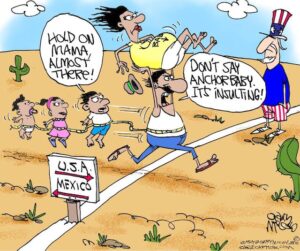
…and just WHO pays for all of this???
While illegal immigrants are restricted from many welfare programs, their children born in America do not face such limitations. Households headed by illegal immigrants and have U.S.-born children are more likely to use welfare than households led by U.S.-born individuals, according to a recent report by the Center for Immigration Studies (CIS).
At least 59.4 percent of illegal immigrant-led homes use one or more welfare programs, compared with 39 percent of households headed by people born in the United States, according to the CIS report.
High rates of welfare use among illegal immigrants “primarily reflect their generally lower education levels and their resulting low incomes, coupled with the large share of those who have U.S.-born children eligible for all welfare programs from birth,” the report stated. “More than half of all illegal immigrant households have one or more U.S.-born children.”
Children born to illegal immigrants in the United States, also known as “anchor babies,” are considered to have automatic birthright citizenship even though the U.S. Supreme Court hasn’t explicitly ruled on the matter. Illegal immigrants can’t access most welfare programs, a restriction that eases for their children who are born in the country.
If a child is born on U.S. soil, that child is automatically a United States citizen. That fact has created a widespread myth that undocumented immigrant parents will do anything to make sure that their child is born inside U.S. borders so that they have an “anchor baby.”
The idea is that having a child who is a U.S. citizen automatically protects the child’s parents from deportation, regardless of their immigration status.
But that’s far from the truth. It’s very difficult for undocumented immigrant parents of a U.S.-born child to obtain legal safeguards against deportation or improve their immigration status.
Illegals and their anchor babies impose a net annual cost of $150.6 billion on American taxpayers
“The American welfare system is designed in large part to help low-income families with children, which describes a large share of immigrants,” CIS stated in the report.
A dozen states offer Medicaid to all low-income children regardless of immigration status. Such children also have access to various government food and meal programs.
The CIS report is based on data from the U.S. Census Bureau’s 2022 Survey of Income and Program Participation (SIPP). “The reality is that illegal immigrants are included in the SIPP, a large share of them are poor, and they or their U.S.-born children have welfare eligibility; and many take advantage of this eligibility,” CIS stated.
“A very large share of immigrants come to America, have children, struggle to provide for them, and so turn to taxpayers for support. This can be seen as especially problematic given that there is already a large number of Americans who are also struggling to provide for their children.”
According to data from the Federation for American Immigration Reform (FAIR), the total number of U.S.-born children of illegal aliens in the United States as of June stood at 5.78 million, a population more than two times that of Chicago.
FAIR estimates that “illegal aliens and their U.S.-born children impose a net annual cost of $150.6 billion on American taxpayers as of the beginning of 2023.” Over the past five years, the annual cost has risen by almost $35 billion.
“This burden will only continue to grow as a result of the Biden administration’s open-borders policies,” the organization warned.
Written by Ava Grace for Natural News ~ January 2, 2024








